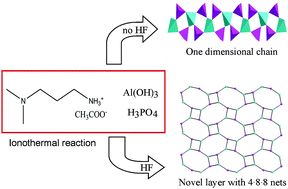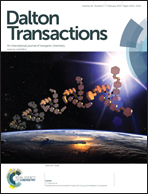Ionothermal synthesis and crystal structures of novel aluminum phosphates with in situ generated templates†
Abstract
Protic ionic liquids (PILs) are a subgroup of ionic liquids and easily formed by proton transfer from a Brønsted acid to a Brønsted base. Two new crystalline aluminophosphates, [C5H16N2][Al(PO4)(HPO4)] (AlPO-PIL1) and [C5H16N2][Al2(OH)2 (PO4)2] (AlPO-PIL2), are successfully prepared for the first time from a protic ionic liquid, 3-dimethylaminopropylamine acetate. Their structures were determined from single-crystal X-ray diffraction data. It was found that HF in the reaction mixture is crucial in determining the selectivity of the phase. In the absence of HF, AlPO-PIL1 with a one-dimensional chain structure was synthesized by templating the protonated 3-dimethylaminopropylamine cation of the PIL. Upon addition of HF to the initial reaction mixture, AlPO-PIL2 was obtained by templating the protonated N,N′-dimethyl-1,3-propanediamine, which was in situ generated from the protonated 3-dimethylaminopropylamine through migration of methyl groups during the crystallization. AlPO-PIL2 has a novel layered structure with a 3-connected 4·8·8 two-dimensional network which has never been found in the previously reported layered aluminophosphates.


 Please wait while we load your content...
Please wait while we load your content...